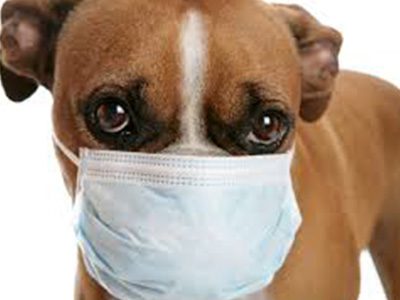
November 14, 2017, by Ryan O’Quinn
When rescuing or adopting a pet, a typical concern for new pet owners when it comes to the ick-factor of pet ownership has more to do with “How am I going to remove that ‘spot’ on the carpet that doesn’t smell like chocolate,” or “Who’s going to be responsible for picking up ‘backyard bombs’ on a regular basis.”
Those concerns are bad enough left alone. But, have you ever stopped to consider the laundry list of harmful and potentially fatal viruses and diseases pets can pass on to their humans? It’s true, humans can get seriously ill from their four-legged friends. Whether you own dogs or cats, you can be at risk of contracting many different viruses from your pets. We’ll discuss the 10 most common ones, the symptoms to look for in pets and people, and how to treat as well as prevent them.
Ringworm
When it comes to diseases passed from pet to owner, ringworm tops this list at number one. Ringworm is about as contagious as it gets concerning pet and human transfer. Ringworm spores can survive for months without a host, where a pet could pick up this fungal infection.
Symptoms in pets: Skin lesions and patches of hair loss with a red mark in the center.
Symptoms in people: Redish or pinkish, circular patches on the skin.
How to treat it: Prescription topical ointment or oral medication for people and pets.
Prevent it by: Washing bedding in hot water twice a month and avoid sharing unwashed bedding, blankets or grooming tools with other pets and their owners.
Hookworms
Hookworms cling to and suck on the intestinal lining of dogs, causing potentially life-threatening blood loss. This is especially true in puppies. The eggs found in pet feces can transfer through the skin in pet owners if you happened to, say, step on a ‘doggie bomb’ with your bare feet. However, that’s just gross in and of itself.
Symptoms in pets: Diarrhea, weight loss.
Symptoms in humans: Often times none but could include an itchy rash, cough, wheezing, stomach pain, anemia and/or loss of appetite.
How to treat it: Prescription antiparasitic drugs for pets and people.
Prevent it by: General prevention for all types of worms includes picking up your dog’s feces in the yard regularly so parasite eggs don’t hatch. Hey, we can help with that!
Roundworm
The most common internal parasite in cats, roundworms resemble spaghetti strings up to 4 inches long. Kittens can be exposed via an infected mother’s milk, while older cats can catch worms by eating an infected rodent. For humans, about 10,000 children are infected with roundworms annually. In its worst-case scenario, the untreated parasitic infection could lead to blindness in humans.
Symptoms in pets: Diarrhea, visible worms in stool, bloody stool, constipation, vomiting and coughing.
Symptoms in humans: Shortness of breath, cough, abdominal pain and blood in the stool.
How to treat it: Prescription antiparasitic drugs for both pets and people.
Prevent it by: Outdoor cats are more prone to worms, so this is a great reason to keep an indoor cat. Always wash hands after handling cats or scooping the litter box. According to the University of Maryland Medical Center, eating bitter and spicy foods like turmeric, cayenne peppers, figs, ginger, olives, and garlic could naturally deter a roundworm infection. Not to mention, those foods are also good for us. Score!
Tapeworms
Kids are more likely than adults to be infected with tapeworm because they tend to not wash their hands before coming into contact with their mouths, especially when eating or drinking. However unpleasant tapeworms may be, they are easily treatable.
Symptoms in pets: Small, rice-looking pieces in the pet’s stool or longer worms can be seen in their vomit.
Symptoms in humans: Rice-looking pieces in stool.
How to treat it: Anti-worm medication for people and pets.
Prevent it by: Keep your pets flea-free. People can actually catch tapeworm by accidentally ingesting a flea infected with the tapeworm larvae.
Toxoplasmosis
A common disease transferred from cats to people, felines are most often infected when they catch and eat raw prey like mice and other rodents. The disease is most dangerous if a woman becomes newly infected just before or while pregnant, as it could cause serious eye and developmental problems in the fetus.
Symptoms in pets: Most cats develop immunity, but kittens are more vulnerable and can experience diarrhea or more serious problems, like lung, liver, or nervous system damage.
Symptoms in humans: Humans can often show no symptoms, but sometimes toxoplasmosis causes flu-like symptoms and swollen lymph nodes. If the symptoms disappear, the disease could still be present in your system.
How to treat it: Blood tests can identify the disease. For humans, drugs such as pyrimethamine and sulfadiazine, plus folinic acid can be used. If you’re at high risk for complications such as women wanting to become pregnant or people with weakened immune systems, you can ask your doctor for a test.
Prevent it by: Don’t let your cat outside to hunt. Always wash your hands after scooping the litter box, and keep cats from going to the bathroom in sandboxes (where your kids play) and gardens (ya, you get the visual).
Giardia
This disease is more common in dogs than cats. This waterborne, single-cell organism lives in rivers, lakes and streams.
Symptoms in pets: Diarrhea.
Symptoms in humans: Diarrhea.
How to treat it: Antiparasitic medication for people. Consult your veterinarian for the best treatment method for pets.
Prevent it by: Taking fresh, clean drinking water for your dog when you go on hikes. Only visit dog parks where owners are responsible about cleaning up after their pets. And always wash your hands after handling your pet’s poop to avoid coming into contact with the disease.
Campylobacter
Campylobacter is one of the most common diarrhea-inducing diseases in the United States. (Clear your calendars folks!) Often humans unknowingly pick up this common bug through kittens, puppies, and even young horses, ferrets, rabbits, and birds.
Symptoms in pets: Diarrhea.
Symptoms in humans: Diarrhea (there seems to be a theme here).
How to treat it: For humans, stay hydrated; sometimes meds are administered, but usually people recover on their own. For pets, your veterinarian can tell you if your pet will require medication.
Prevent it by: Avoid excessive holding or kissing if a kitten or puppy is sick with diarrhea. Even after the pet has recovered, wash your hands after touching him; an animal infected with Campylobacter continues to shed germs for up to seven weeks if left untreated.
Salmonella
We see the warning on the raw cookie dough packages and know not to eat raw eggs because baby chicks can carry the germ. And, did you know that between 75 to 90% of reptiles harbor salmonella.
Symptoms in pets: Reptile pets and chicks often don’t show symptoms.
Symptoms in humans: Abdominal pain, fever, vomiting, headache, nausea.
How to treat it: Most people recover without treatment, but some need to be hospitalized in more serious cases.
Prevent it by: Making sure everyone always washes their hands after handling a pet reptile or chicken. Never wash a tank in your kitchen sink. If you wash it in the bathtub, be sure to disinfect the tub immediately thereafter.
Bubonic Plague
When you hear of the Bubonic Plague, it probably conjures images of medieval times, right? While you can’t get this directly from your pet, you could catch it from a hitchhiking flea. Luckily, it’s extremely rare—CDC reports an average of just seven human cases per year. However, one case is too many.
Symptoms in pets: Fever, inflammation, swollen and painful lymph nodes.
Symptoms in humans: Sudden fever, headache, chills, weakness, swollen and painful lymph nodes.
How to treat it: Treat promptly with antibiotics for people and pets.
Prevent it by: Keeping your pet free of fleas.
Rabies
Although rare in the United States, rabies is fatal once symptoms appear in both pets and other animals. So prevention is of the utmost concern.
Symptoms in pets: Symptoms vary but could include behavioral changes like aggression, fever, hypersensitivity to touch, light, sound, hiding in dark places, foaming of the mouth, staggering, seizures, loss of appetite and sudden death.
Symptoms in humans: Flu-like symptoms, headache, anxiety, confusion, agitation, hallucinations and general weakness.
How to treat it: If you believe you may have been exposed to a rabid animal, seek immediate medical attention. Doctors may start a series of post-exposure shots to protect you from the virus. Left untreated, rabies is almost always fatal. Call the vet immediately if you believe your pet was exposed.
Prevent it by: Keeping your pets vaccinated in accordance with local and state rabies laws. Always keep pets away from wild animals. Tell your doctor if you’re bitten or scratched by an unknown or unvaccinated dog, cat, or wild animal.
As usual, prevention is always preferred. As the saying goes, the best offense is a good defense. Keep yours and your pet’s living quarters and bedding clean, wash hands diligently and if anything looks or seems like odd or unusual behavior for your pet, call your vet immediately.
After taking all that in, picking up dog poop regularly doesn’t seem all that bad now, does it?








